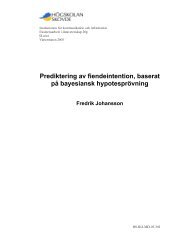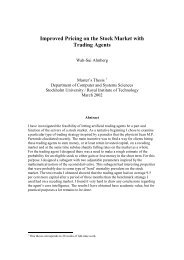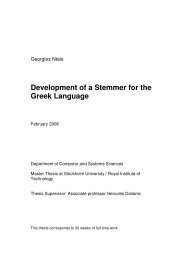Modeling Hydra Behavior Using Methods Founded in Behavior-Based Robotics
Modeling Hydra Behavior Using Methods Founded in ... - SAIS
Modeling Hydra Behavior Using Methods Founded in ... - SAIS
Create successful ePaper yourself
Turn your PDF publications into a flip-book with our unique Google optimized e-Paper software.
7.1. Generation of behaviors 33................... ..❘✓✏❯...3✒✑... ✒.❦ .✣.... ..... .... . . . ..... ........❅ ✓✏... ❅❘❫ .....1✒✑. .✻ ... ✻.... ... . . . . .. ............. . . .. .............✓✏ ❄2.✒✑...✣❅■ .... .. ❅.. .. . . . .✲Figure 7.2: Evolved RNN habituation model.Response strength from 3 unit RNN10.9Tra<strong>in</strong><strong>in</strong>g data, ISI = 8Output from RNN at ISI = 8Output from RNN at ISI = 4Output from RNN at ISI = 160.8Response strength0.70.60.50.40.30.20.10.2 0.4 0.6 0.8 1 1.2 1.4 1.6 1.8 2Time [s]x 10 4Figure 7.3: Response strength for best evolved RNN-based habituation model. ISIs are presentedhere <strong>in</strong> time-step units (1 time-step equals 2s, as described above). While the RNN performs wellon tra<strong>in</strong><strong>in</strong>g data (ISI = 8), note that the recovery from habituation is not adequate for stimulus ofISI = 4.





